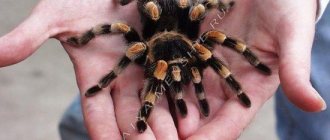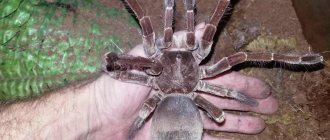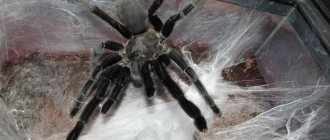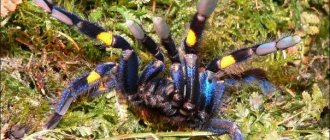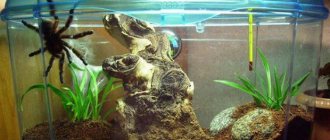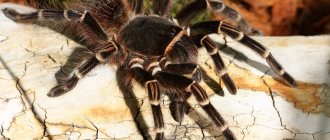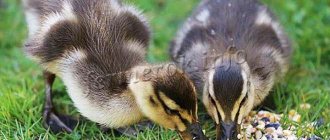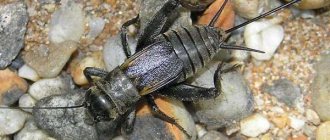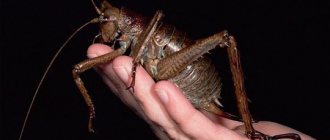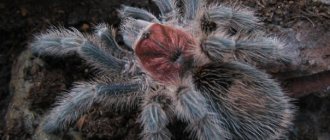Exotic pet lovers often choose spiders as pets. These creatures have an unusual and terrifying appearance, although they are relatively harmless to humans and do not require much space to maintain. Tarantulas have gained particular fame due to their size and unusual appearance. At home, they can live 15 years, and some even more. But for a pet to live such a long life, it needs to choose the right diet.
House spider tarantula for beginners
As a rule, large spiders are found in the tropics, where the climate is constantly warm and humid. Some species prefer to live in the ground, where they build entire labyrinths, as well as in trees, constructing huge trapping nets. Often, the habitat of some species depends on age: at a young age they are found in the thickness of the earth, and as they grow older they move to trees or plants.
It is important to know! When keeping the tarantula spider at home, conditions should be created that are close to natural. To do this, before purchasing it, you need to study the features of the environment in which they prefer to live. If this is not done, the animal will quickly die from stress.
You should always remember that these spiders are poisonous, despite the fact that they have a peaceful nature and do not show aggression. For beginners, we can recommend the following types:
- Brachypelma Albopilosum (Brachipelma Albopilosum) leads a terrestrial way of life and is distinguished by the most calm behavior. The body size, which has a pinkish-brownish color, reaches about 16 cm. The spider bites painfully, but its bite does not pose a danger to humans. Females can live about 20 years, while males live only 3 years. It is unpretentious in care, and the diet is based on small insects. Can weave a web, although not a large one.
- Avicularia Versicolor prefers to live in trees. Adults are distinguished by their bright colors, with a predominance of blue-blue tones. The body length is about 5 cm, and together with the paws - 16 cm. It weaves a huge web, making a hole out of it for itself and securing it under the ceiling of the terrarium. It leads a nocturnal lifestyle, and during the daytime it stays in its shelter. It moves quite quickly, so it is very difficult to catch it. Females can live for about 8 years, while males can live for only a couple of years. Although the spider is poisonous, its poison is not dangerous to humans. You can pick up the spider without any problems, since its hairs do not contain toxic components.
For professionals, the species “Lasiodora Parahybana”, “Grammostola”, “Acanthoscurria” are suitable. The Goliath tarantula is considered a real decoration of any collection, and is also one of the most beautiful spiders in the world. Reaches a length of about 28 centimeters.
Spider - tarantula - the kindest female walks, eats and gives a paw!))
Choosing a home
After choosing a spider, you should think about where it will live. For a spider, it doesn’t matter where to live, the main thing is that the conditions there are good. Food containers can serve this purpose - this will be the best home for the spider if it is still small. You need to make holes in the container for ventilation, fill it with soil and that’s it. Convenient, practical, not expensive. However, if you decide to provide the spider with a more beautiful home, then for this purpose you will already need a terrarium. How to choose a terrarium? It all depends on the type of spider: there are terrestrial, burrowing, arboreal and intermediate species. It is worth considering that the type of young and adult spiders may differ. For ground spiders, horizontal or cubic terrariums are suitable. These spiders can be found much more often walking around your home. For burrows, both a horizontal and a cubic terrarium may be suitable, but it is worth considering that a large amount of soil should be poured into it. In addition, burrow spiders really do not like to be in plain sight and come to the surface only at nightfall, while semi-burrowing species can stay near the burrow and hide in case of danger. Woody species require a vertical terrarium. Such spiders will build air tunnels from their webs, sometimes embedding a small amount of soil into them to strengthen their homes. Regarding the size of the terrarium, it should be said that you should not strive to purchase a huge terrarium, since the animal will be constantly under stress, and this will affect its health. The fact is that spiders prefer to be safe in narrow conditions, so if you put a spider in a large space, you risk its health. In the wild, spiders also look for any voids, cracks in trees, or hollows, or even dig holes themselves where they feel safe. You can arrange the terrarium itself by putting in it shelters for the spider, all kinds of driftwood and decorations. Such arrangement is sometimes even necessary, especially for tree species that require a foundation for building a home. However, when installing natural decor, such as live plants, driftwood, or bark, into a terrarium, you need to be careful - organic materials can begin to rot or mold, and pathogenic bacteria can also develop on them. Such materials should be treated thermally, but in no case should insecticides or toxic substances be used, as they can harm the spider.
Terrarium 30*30*30 cm PetPetZone (spider)
What to feed a tarantula spider at home
Many believe that, judging by the name, these spiders feed on birds. In fact, this is not the case, since the diet of such animals in nature is very diverse. Therefore, the diet of tarantula spiders consists of:
- From crickets.
- From grasshoppers.
- From cockroaches.
- From flies.
- From moths.
- From moth caterpillars.
Tarantula spiders kept at home are occasionally given chicken (raw), fish, and small rodents. Adults are fed 2 times a week, and juveniles are given food 4 times a week.
Description of the species
The Latin name for the tarantula Irminia is psalmopoeus irminia. It was first found on the South American continent, in Venezuela. The individual was found under the bark of a tree. Arachnologists define the spider's range as the northwestern territory of South America. The animals live in Venezuela, Guyana, an island part of the Atlantic Ocean. The tarantula was described in 1994.
The main color of psalmopoeus irminia is dark. The abdomen is brick-colored. Along the center there is a wide black stripe. It is crossed by horizontal stripes. Orange color is noted on the limbs. Vertical stripes are noted on 2-3 phalanges. The hair pads at the ends of the paws are black. The tarantula's back is dark, but a pattern can be discerned on it. It is decorated with orange and red splashes.
- A medium-sized spider: body length 6 cm, paw span 15 cm. It is a long-livers. The female can live up to 15 years. It reaches a large body size at 10 years of age. Young individuals molt frequently, once every 2 weeks. Their rapid growth occurs until puberty. During puberty, their reproductive organs develop. After this, the spiders are considered adults. Their growth is slowing down. Shedding occurs once a month. Then, once every 6 months. Mature tarantulas shed their exoskeleton once a year.
- The tarantula Irminia reaches adulthood at 8 months. Females develop closer to 2 years. Some keepers, when keeping spiders at home, specifically inhibit the growth of males. To do this, they lower the temperature and reduce the protein diet of individuals.
- The female begins to build a cocoon 2 months after fertilization. A clutch can contain 500 eggs. To ensure that they are distributed evenly throughout the cocoon, the female turns it over with her limbs. She does not leave him without attention, does not leave the nest, even when severely exhausted.
- Nymphs appear after 2.5 months. You don't need to feed them. They feed on leftover egg yolks. After 3 molts, they develop into larvae that look like small spiders. They are fed maggots and zophobas beetle larvae; the size of the larvae can reach 6 cm; spiders are given ¼ part.
- The Irminia tarantula withstands temperature changes well. Some species live in the mountains, at an altitude of 600 m above sea level. A comfortable temperature for them is 19-22 0C. Individuals that prefer tropical forests are accustomed to higher temperatures, 26-28 0C.
- Animals are sensitive to air humidity of 80%.
Loading …
The venom of spiders is highly toxic, but individuals are not aggressive. They release poison only during hunting or when they sense danger. The main natural enemies of tarantulas are larger vertebrates. Aga toads can climb into the burrows of young animals and eat spiders and eggs of arthropods.
The keeper's hand in the terrarium can cause stress in the animal. At the slightest change in the spider’s behavior, the hand must be removed. Otherwise, the individual will attack and bite.
Rules of care and maintenance
Spiders are perhaps the easiest animals to keep at home, although it cannot be said that they do not need care at all. The most important thing is that they behave very calmly and do not leave as much garbage behind them as from other animals. To keep a tarantula spider, you will have to acquire either an aquarium or a terrarium. The most important thing is that conditions close to natural ones be created inside such a container. For spiders living under the surface of the earth, it is necessary that at the bottom there is a substrate at least 5 cm thick, consisting of soil and bark. For individuals living above the surface of the earth, it is necessary that driftwood be present. Here the spider will weave a web and hide in its shelter.
It is important to know! Spiders prefer twilight, so they do not need bright lighting. In addition, the terrarium should be placed in a warm corner of the apartment or room, away from direct sunlight. In winter, additional heating will be required to maintain the temperature inside the container at +25 degrees.
Care involves monitoring the cleanliness of the terrarium, regularly removing food debris, skin after molting, removing young spiders, as well as males after mating, otherwise cannibalism is possible. It is imperative to maintain humidity at the required level to prevent the skin from drying out. If this is not done, the animal will begin to get seriously ill.
Arachnid Phalanx
This spider can also be called a camel spider due to the hump on its back. All individuals of this species are very active, but are strictly nocturnal. The body and limbs are covered with hairs.
Phalanx arachnids are characterized by fast reactions
The individuals' vision is quite remarkable. They have another extra pair of eyes on the sides, like scorpions. Spiders distinguish light and are able to react to movement. Due to this, the arachnid's reaction is very fast. It attacks the victim with a delay of a split second, thanks to which the giant spider is considered not only an excellent hunter, but also an elusive creature.
Another notable feature of the spider is its chelicerae. They are so strong and durable that it can bite through not only the skin, but also a human nail. Externally, each chelicera resembles a crab claw. It is with them that he rips off the fur and feathers from his prey, and then lines his home with the material.
Reproduction
The sex of a tarantula spider is easy to determine if you follow the recommendations of experts. Young spiders begin to molt after about a month. After molting, the skin is taken and carefully examined. In the posterior region of females there is a depression, and in males there are something like two tubercles. If the individuals are adults, then the sex can be determined by appearance. Males have slightly slimmer legs and are taller, while the body is significantly smaller in size than the female.
After mating, the eggs develop inside the female for 2 months. During this period, she must form a special cocoon. At one time, she can lay up to 500 eggs, while about 50 spiders remain alive. In order for the juveniles to actively develop, the cocoon is moved to a separate terrarium, thereby creating certain temperature conditions.
For the first month, baby spiders do not eat anything, until the first molt. Until this moment, they can be together, after which they are separated one by one. A female tarantula spider molts up to 12 times during her entire life. Males stop moulting immediately after puberty.
Interesting to know ! The tarantula spider is constantly growing and maturing, which is why it needs to shed its “old clothes”. Before molting, individuals turn over on their backs, trying to remove their old skin. At the same time, he completely stops eating. After molting, the spider gets a new color, and the pile is completely renewed.
Tarantula spiders for beginners. WHICH SPIDER TO GET FIRST????
The appearance of offspring
If fertilization is effective, then after 2 months the female lays eggs. Shortly before the predicted laying, it is recommended to replace the soil or clean the terrarium. All remaining feed is removed, preventing the process of rotting. The drinking bowl is cleaned and filled with clean water.
Formation of a cocoon by a female tarantula spider
When breeding tarantula spiders at home, it is necessary to follow the rules of hygiene for arthropods. Individuals are fed protein food: darkling beetle larvae, Madagascar cockroaches.
- If the female begins to abundantly weave the terrarium with cobwebs. This means that she is preparing to lay. It lines the bed, which consists of dense fabric.
- The spider lies down on him and releases eggs from her abdomen. They come out along with a viscous liquid. At this time, the female’s abdomen sharply decreases.
- After laying, the individual begins to collect the entire web into a cocoon. It looks like a small ball.
- The spider constantly moves the cocoon to certain places in the terrarium, looking for the optimal microclimate.
- The air temperature in the container is kept at 24 0C, the humidity is increased to 70%, but you should always be based on the characteristics of the subspecies. Some spiders require higher air temperatures and maximum humidity.
- The incubation period lasts 1-2 months, but already at 35 days nymphs appear in the cocoon. The female helps them break the cocoon.
After the spider has formed a cocoon, it is recommended to inspect it for integrity. Young females do not completely cover the clutch with cobwebs. The eggs may die.
To prevent this from happening, it is recommended to take the cocoon from the female by tossing her a dummy. The holes in the cocoon are sewn up with silk thread and returned to the female. If she does not accept it, then incubation is performed artificially.
Nymphs emerge from the cocoon. They are placed in a separate container, provided with high humidity, and maintained at a temperature of 26-28 0C. You don't need to feed them. They feed on egg yolk. After a month they develop into larvae. I distribute the young animals into separate containers and begin feeding.
The larvae are kept at a temperature of 22-26 0C. Air humidity 70%. You need to be prepared for the fact that tarantulas are fertile. The required number of terrariums and food insects should be prepared.
YouTube responded with an error: The request cannot be completed because you have exceeded your quota.
Danger to humans
Before you get such an undemanding pet at home, you should find out how poisonous it is. It must be remembered that although this type of spider can bite a person, these bites do not pose a danger.
The animal can bite if it feels its life is threatened, but before that it can rise on its hind legs and create menacing hissing sounds. The tarantula spider bites with chelicerae, at the end of which there are fangs, the length of which is about 2 cm. During the bite, it injects poison.
The bite site becomes inflamed, followed by swelling and swelling. All this is accompanied by pain. After about a week, the negative consequences of the bite disappear. This is especially true for people prone to allergies, as well as those with weakened immune systems. After a bite, such people experience a deterioration in their general health and severe weakness, with nausea, diarrhea, dizziness and headache.
Spiders cannot be trained in any way, so a person must study their behavior patterns. If the spider has poisonous hair, then it is better to handle it while wearing gloves, otherwise it may irritate the skin.
It is important to know! There is a category of people suffering from arachnophobia - fear of spiders. If such a person accidentally and unexpectedly encounters a tarantula spider, he may die of fear. In this regard, it is necessary to ensure that the animal is not able to leave the terrarium and does not start traveling around a person’s home, or even worse, among its neighbors.
Precautionary measures
With the exception of some rare species, tarantulas do not pose a threat to human life.
Many owners of these exotic pets enjoy holding them in their arms.
The arthropods themselves may initially experience stress, however, they gradually get used to tactile contact and behave quite calmly.
However, when caring for these exotic pets and communicating with them, experts recommend using protective gloves.
In stressful situations, insects shed hairs from their abdomen, causing pronounced allergic reactions, especially when they get into the respiratory tract or visual organs.
In addition, pet vinegars are quite painful.
The venom secreted by most tarantulas is considered to be of low toxicity, however, pain, swelling, and allergies are extremely unpleasant symptoms. Pets should be taught to tactile contact carefully and gradually.
When picking up an animal, even with protective gloves, it is recommended to avoid sudden movements.
People who have an increased tendency to allergic reactions should refrain from close contact with such exotic animals.
How much does a tarantula spider cost?
These exotic animals are not that cheap, as some of the species cost a lot of money. You can purchase a tarantula spider in various ways: via the Internet or through an advertisement, or by going to a pet store. Depending on the type, you will have to pay from 100 to 10 thousand rubles. Moreover, females are always more expensive.
When choosing a pet for yourself, you should pay attention to a number of factors, including age. It is better not to buy too large individuals, as they may be old. Secondly, you should pay attention to the shell. If they are damaged or have wrinkles or cracks, it is better not to take such individuals, as they may turn out to be sick. It is not recommended to buy spiders before or immediately after molting, since it is not possible to determine how active the animal is.
Priming
If we figured out the terrarium and the spider, now we need to know what to put in the spider’s terrarium. The soil is very important, since it serves as the basis for the home, it is important for maintaining humidity, and besides, it is through the soil that spiders will drink - they will most likely either mercilessly bury the drinking bowl, or weave it, or even shit in it. Selecting soil is quite easy. It should allow air to pass through well, not mold, maintain the required level of humidity and not be too small. Therefore, ordinary soil is not suitable for flowers; moreover, it may contain insecticides. Decorative sand or regular sand are also not suitable, since the sand contains very small particles that the spider can inhale and die. Coconut substrate is best suited for these purposes. Now it has gained great popularity; it can be easily obtained in almost any store for a relatively low price. It is also not recommended to use vermiculite or perlite, because these substrates contain many small particles; in addition, spiders living on these soils often become more aggressive, apparently experiencing stress.
Taxonomy
Family Theraphosidae
includes 143 genera:
- Acanthopelma
F.O. Pickard-Cambridge, 1897 - Acanthoscurria
Ausserer, 1871 - Acentropelma
Pocock, 1901 - Aenigmarachne
Schmidt, 2005 - Agnostopelma
Pérez-Miles & Weinmann, 2010 - Aguapanela
Perafan & Cifuentes, 2015 - Ami
Perez-Miles, 2008 - Annandaliella
Hirst, 1909 - Anoploscelus
Pocock, 1897 - Antillena
Bertani, Huff & Fukushima, 2017 - Aphonopelma
Pocock, 1901 - Augacephalus
Gallon, 2002 - Avicularia
Lamarck, 1818 - Bacillochilus
Gallon, 2010 - Barropelma
Chamberlin, 1940 - Batesiella
Pocock, 1903 - Bistriopelma
Kaderka, 2015 - Bonnetina
Vol, 2000 - Brachionopus
Pocock, 1897 - Brachypelma
Simon, 1891 - Bumba
Perez-Miles, Bonaldo & Miglio, 2014 - Cardiopelma
Vol, 1999 - Caribena
Fukushima & Bertani, 2017 - Catanduba
Yamamoto, Lucas & Brescovit, 2012 - Catumiri
Guadanucci, 2004 - Ceratogyrus
Pocock, 1897 - Chaetopelma
Ausserer, 1871 - Chilobrachys
Karsch, 1892 - Chromatopelma
Schmidt, 1995 - Citharacanthus
Pocock, 1901 - Citharognathus
Pocock, 1895 - Clavopelma
chamberlin, 1940 - Coremiocnemis
Simon, 1892 - Cotztetlana
Mendoza, 2012 - Crassicrus
Reichling & West, 1996 - Cubanana
Ortiz, 2008 - Cyclosternum
Ausserer, 1871 - Cyriocosmus
Simon, 1903 - Cyriopagopus
Simon, 1887 - Cyrtopholis
Simon, 1892 - Davus
O. Pickard-Cambridge, 1892 - Dolichothele
Mello-Leitão, 1923 - Encyocratella
Strand, 1907 - Encyocrates
Simon, 1892 - Ephebopus
Simon, 1892 - Euathlus
Ausserer, 1875 - Eucratoscelus
Pocock, 1898 - Eumenophorus
Pocock, 1897 - Eupalaestrus
Pocock, 1901 - Euphrictus
Hirst, 1908 - Eurypelmella
Strand, 1907 - Euthycaelus
Simon, 1889 - Grammostola
Simon, 1892 - Guyruita
Guadanucci, Lucas, Indicatti & Yamamoto, 2007 - Hapalopus
Ausserer, 1875 - Hapalotremus
Simon, 1903 - Haploclastus
Simon, 1892 - Haplocosmia
Schmidt & von Wirth, 1996 - Harpactira
Ausserer, 1871 - Harpactirella
Purcell, 1902 - Hemirrhagus
Simon, 1903 - Heterophrictus
Pocock, 1900 - Heteroscodra
Pocock, 1900 - Heterothele
Karsch, 1879 - Holothele
Karsch, 1879 - Homoeomma
Ausserer, 1871 - Hysterocrates
Simon, 1892 - Idiothele
Hewitt, 1919 - Iridopelma
Pocock, 1901 - Ischnocolus
Ausserer, 1871 - Kankuamo
Perafan, Galvis & Perez-Miles, 2016 - Kochiana
Fukushima, Nagahama & Bertani, 2008 - Lampropelma
Simon, 1892 - Lasiodora
C.L. Koch, 1850 - Lasiodorides
Schmidt & Bischoff, 1997 - Longilyra
Gabriel, 2014 - Loxomphalia
Simon, 1889 - Loxoptygus
Simon, 1903 - Lyrognathus
Pocock, 1895 - Magnacarina
Mendoza, Locht, Kaderka, Medina & Pérez-Miles, 2016 - Magulla
Simon, 1892 - Mascaraneus
Gallon, 2005 - Megaphobema
Pocock, 1901 - Melloleitaoina
Gerschman & Schiapelli, 1960 - Metriopelma
Becker, 1878 - Miaschistopus
Pocock, 1897 - Monocentropus
Pocock, 1897 - Munduruku
Miglio, Bonaldo & Pérez-MIles, 2013 - Mygalarachne
Ausserer, 1871 - Myostola
Simon, 1903 - Neischnocolus
Petrunkevitch, 1925 - Neoheterophrictus
Siliwal & Raven, 2012 - Neoholothele
Guadanucci & Weinmann, 2015 - Neostenotarsus
Pribik & Weinmann, 2004 - Nesiergus
Simon, 1903 - Nesipelma
Schmidt & Kovařík, 1996 - Nhandu
Lucas, 1983 - Omothymus
Thorell, 1891 - Ornithoctonus
Pocock, 1892 - Orphnaecus
Simon, 1892 - Ozopactus
Simon, 1889 - Pachistopelma
Pocock, 1901 - Pamphobeteus
Pocock, 1901 - Pelinobius
Karsch, 1885 - Phlogiellus
Pocock, 1897 - Phoneyusa
Karsch, 1884 - Phormictopus
Pocock, 1901 - Phormingochilus
Pocock, 1895 - Phrixotrichus
Simon, 1889 - Plesiopelma
Pocock, 1901 - Plesiophrictus
Pocock, 1899 - Poecilotheria
Simon, 1885 - Proshapalopus
Mello-Leitão, 1923 - Psalmopoeus
Pocock, 1895 - Psednocnemis
West, Nunn & Hogg, 2012 - Pseudhapalopus
Strand, 1907 - Pterinochilus
Pocock, 1897 - Pterinopelma
Pocock, 1901 - Reichlingia
Rudloff, 2001 - Reversopelma
Schmidt, 2001 - Sahydroaraneus
Mirza & Sanap, 2014 - Schismatothele
Karsch, 1879 - Schizopelma
F.O. Pickard-Cambridge, 1897 - Selenocosmia
Ausserer, 1871 - Selenogyrus
Pocock, 1897 - Selenotholus
Hogg, 1902 - Selenotypus
Pocock, 1895 - Sericopelma
Ausserer, 1875 - Sickius
Soares & Camargo, 1948 - Sphaerobothria
Karsch, 1879 - Stichoplastoris
Rudloff, 1997 - Stromatopelma
Karsch, 1881 - Tapinauchenius
Ausserer, 1871 - Theraphosa
Thorell, 1870 - Thrigmopoeus
Pocock, 1899 - Thrixopelma
Schmidt, 1994 - Tmesiphantes
Simon, 1892 - Trichognathella
Gallon, 2004 - Trichopelma
Simon, 1888 - Typhochlaena
C.L. Koch, 1850 - Vitalius
Lucas, Silva & Bertani, 1993 - Xenesthis
Simon, 1891 - Ybyrapora
Fukushima & Bertani, 2017
Some information about insects
There are about 42,000 species of these insects in the world, and they live all over the planet, although many representatives prefer to settle in places with a warm climate. More than 2,900 species are found in Russia and the CIS. All types of these “pets” are predators; spiders eat small animals and insects. Spiders in an apartment can also eat insects that fly and crawl in the summer. Many insect species prefer to use webs to obtain prey. Killing the victim is carried out through poison - digestive juice.
Sources
- https://felisov.ru/pauki/skolko-zhivut-obychnye.html
- https://stopklopu.com/skolko-zivut-pauki-v-kvartire-iv-prirode/
- https://tekstil-doma.ru/uborka/skolko-zhivut-domashnie-pauki-obychnye.html
- https://WikiParazit.ru/pauki/skolko-zhivut-pauki-i-ot-chego-eto-zavisit.html
- https://kursi-floristiki.ru/pauki/prodolzhitelnost-zhizni-pauka.html
- https://parazitdoma.ru/drugie-parazity/skolko-zhivut-pauki
- https://WikiParazit.ru/pauki/skolko-zhivut-pauki.html
- https://SafariCentr.ru/nasekomye/skolko-zhivet-pauk-2.html
- https://dwtb.ru/yadovitye-nasekomye/skolko-zhivut-pauki-obychnye.html
- https://MyRzd.ru/nasekomye/skolko-zhivet-pauk-2.html
- https://agrovetspb.ru/nasekomye/kakie-byvayut-i-skol-ko-zhivut-pauki-osobennosti-prodolzhitel-nosti-zhizni-arahnid.html

